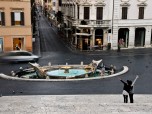The Theater of Marcellus was built in Rome, Italy near the end of the first century BC, during the final years of the Roman Republic. The theater is open to the skies, and in its prime it hosted both singing competitions and drama performances. It was used as a fortified stronghold during medieval times, and is now one of the Italian capital’s most famous tourist attractions.
Background and Construction
The theater takes its name from the nephew of the Emperor Augustus, Marcus Marcellus. However, the child never saw it in its final state, as he died several years before the building was completed. The original plans for a theater on the site had been made by Julius Caesar, who had ordered space to be cleared for it, but his murder in 44 BC occurred before any construction work had taken place.
Augustus decided to restart work on the theater in 22 BC. Five years later, enough work had been completed on the building that it was able to host part of the Secular Games, a major celebration which was intended to take place every century. The building was finished in 13 BC, and the emperor inaugurated the site the following year.
Dimensions and Layout
In its original form, the theater was capable of holding around 11,000 people. The main construction materials were tuff, a type of rock formed from compacted volcanic ash, and concrete. This was faced with stones and covered in brilliant white travertine limestone. Openings were built into the structure to allow southeastern views of Tiber Island. The whole complex had a diameter of around 340 feet.
Inside the theater was a mass of corridors, ramps, tunnels, and arches, which allowed access from the exterior. As was usually the case with such buildings in Ancient Rome, these areas carried considerable ornamentation in the form of columns in a mixture of the Doric and Ionic styles. Most authorities hold that the upper level employed Corinthian columns, but these were lost when the theater was rebuilt during the Middle Ages.
Later history
By the end of the 10th century, the theater was largely in ruins, although it was still known by the name Templum Marcelli, or Temple of Marcellus. At around this time, the descendants of the Fabii, an important patrician family in Roman days, used the theater as a fortress. In the late 11th century, it was used for similar purposes by the Pierlioni.
By the 13th century, the fortress had passed into the hands of the Savelli, but thereafter it began to lose its strategic importance, especially after the advent of gunpowder. By the 16th century, Baldassare Peruzzi’s mansion for the Orsini had been built over the top of what remained of the Roman theater itself.
The structure had now reached its modern form, in which the upper part is split into a number of apartment dwellings. The grounds of the theater are a popular location for small-scale concerts in summer, while the Portico d’Ottavia links the site to the Tiber. The design of the Sheldonian Theatre in Oxford, England was strongly influenced by the Theater of Marcellus.





































